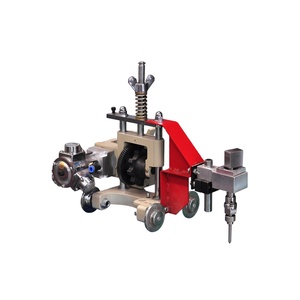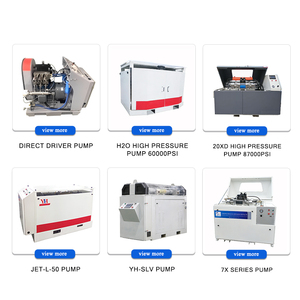
All categories
Featured selections
Trade Assurance
Buyer Central
Help Center
Get the app
Become a supplier

(2366 products available)



















Handheld Water Jet Cutting Machines:
A handheld portable water jet cutter allows operators to manually direct the jet stream when cutting. These types of water jet cutters give more freedom of movement than other styles. Usually, handheld water jet cutters weigh less than 30 kg and are used to cut smaller workpieces like metal pipes and plates. However, they are ideal for quickly and easily producing non-standard parts, seams, openings, etc. Therefore, they are suitable for the repair and maintenance industry. Typically, these cutters are easy to move around. They also have simple control systems that allow operators to adjust the cutting speed and pressure easily. Handheld water jet cutters are used extensively in places where complex shapes or tight tolerances must be cut quickly.
Robot Water Jet Cutting Machines:
The portable water jet cutting robots are pre-programmed to cut a wide range of materials with complex and delicate shapes. They are more flexible than traditional cutting techniques, and these robots offer a precise cutting solution that is non-contact and cost-effective. The machines allow users to modify and program in accordance with their needs, making them a versatile alternative to conventional cutting methods. They are generally equipped with intricate software and cutting tools that can handle complicated cuts, engravings, and designs with minimal waste and error. This makes them suitable for cutting non-metallic materials such as glass, stone, ceramics, and composite materials.
Semi-Automatic Portable Water Jet Cutting Machines:
The semi-automatic portable water jet cutter is a more sophisticated device than the manual one. This kind of machine integrates manual operation with automated features so that it can perform various cutting tasks effectively. The semi-automatic cutter is usually more portable than other types of water jet cutters. Its weight can be around 60 kg or less, making it easy to carry from one place to another. The operator can use it to cut through metal sheets, plates, and pipes with the assistance of an automated feature that ensures more accurate and consistent cuts. Semi-automatic water jet cutters are popular in small-to-medium-sized workshops that produce parts with higher precision demands.
Portable water jet cutters come with a variety of specifications that determine their cutting efficiency and ability.
Regular maintenance of these water jet cutting machines is very important to help ensure reliable operation, optimal cutting performance, and prolonged equipment lifespan. A maintenance schedule should be created based on usage patterns, cutting intensity, and environmental conditions. Some suggested maintenance routines include regular inspections to detect signs of wear, damage, or leaks early, establishing a periodic cleaning schedule with appropriate solutions and a manual to avoid critical clogs and contamination, and setting up water treatment systems to help remove impurities for better jet quality and less hassle and conducting timely software updates for CNC control system stability and adding lubricants for the cutter's moving parts for smoother, more accurate motions. It is also important to employ the use of genuine parts after repair or replacement to maintain cut quality and jet integrity.
Due to their numerous advantages, portable water jet cutters have broad applications in various industries.
Metal and material cutting
The primary application of portable water jet cutting machines is cutting various metals. They can quickly cut a variety of materials, including metal plates, stainless steel, aluminum, brass, carbon steel, titanium, and more. The precision and quality of the cuts made by these machines are excellent. Complex shapes with narrow curves, notches, and tight tolerances can be cut without distorting, damaging, or affecting the material's structure. This makes water jet cutters perfect for industries like aerospace, automobile manufacturing, shipbuilding, metal fabrication, and others that use metals.
Stone Cutting
Portable water jet cutters are widely used to cut stone materials such as marble, granite, quartz, and ceramic for the construction and decoration industries. They are ideal for creating intricate patterns, beautiful engravings, and precise stone carvings. Additionally, water jet cutters can provide high-accuracy cuts with minimal material waste. As a result, fewer raw materials are used, making production processes more efficient.
Glass cutting
The use of water jet cutters for glass cutting is a rather novel method. These machines can be used to cut glass of any kind, including float glass, tempered glass, laminated glass, etc., with stunning results and little post-processing required. Water jet cutters are perfect for making cutouts, holes, and decorative patterns in glass because, unlike laser or flame cutters, they don't produce heat that could cause cracking or breakage.
Other materials
Additionally, portable water jet cutting machines can be used to cut various other materials, including rubber, foam, plastics, sand, and even food. Additionally, water jet cutting machines can be used to cut complex and thick materials like composite materials, titanium alloys, and high-strength steels. Their cutting precision and quality are indispensable advantages.
When shopping for premium-quality portable water jet cutters, buyers should go for models with the features most pertinent to their operations. This could vary greatly depending on the specific use case but will generally include pressure, cutting thickness, accuracy, control system, and material.
Pressure
Super buyers should consider the pressure of the water jet cutting machine. Different pressure levels are better suited to different kinds of materials and cutting thicknesses. Higher pressures are often more versatile but can also be more expensive.
Cutting Thickness
Super buyers should consider the material thickness that the water jet cutting machine can handle. If they will be cutting particularly thick materials, they'll need to invest in a machine that's capable of doing so.
Accuracy
They should also check the accuracy of the water jet cutter in question. If cutting precision is paramount to a buyer's projects, they will need to look for a machine that offers high levels of precision.
Control System
Super buyers should also consider the control system used to operate the water jet cutter. Some machines have CNC (computer numerical control) systems that allow for highly automated and precise cutting, while others have more basic control methods.
Material Compatibility
A portable water jet cutter's design and construction will determine whether or not it can effectively cut through different kinds of solids, liquids, and gases. Therefore, buyers should look for water jet cutters that are capable of cutting the material they usually work with.
Q1: What type of equipment does a water jet cutting machine need?
A1: A water jet cutting machine requires the following main pieces of equipment: a high-pressure pump that provides the jet with the necessary pressure; a cutting head that directs and controls the water jet; a stirrer that mixes the water with abrasives; and a controller that controls the movement path and speed of the water jet.
Q2: How safe is water jet cutting?
A2: Water jet cutting is considered a safe processing technology and does not produce dust and debris. However, it still emits some noise. Therefore, operators can wear a seat belt or earplug when using the equipment.
Q3: Is portable water jet cutting environmentally friendly?
A3: Water jet cutting is considered an environmentally friendly cutting method. It does not produce gas and dust. Operators can cut with water jets instead of water, reducing water waste.
Q4: What materials cannot be cut with water jets?
A4: This machine cannot cut some materials, such as materials requiring extremely high cutting temperatures, like ceramics; thin materials, such as films and nets; and flammable and explosive materials.